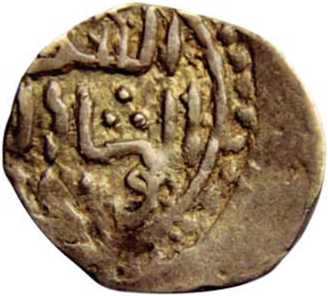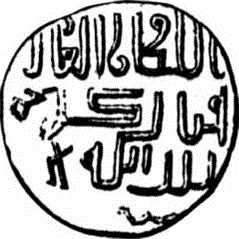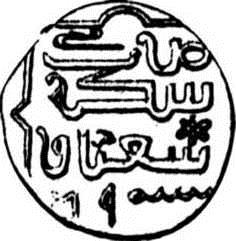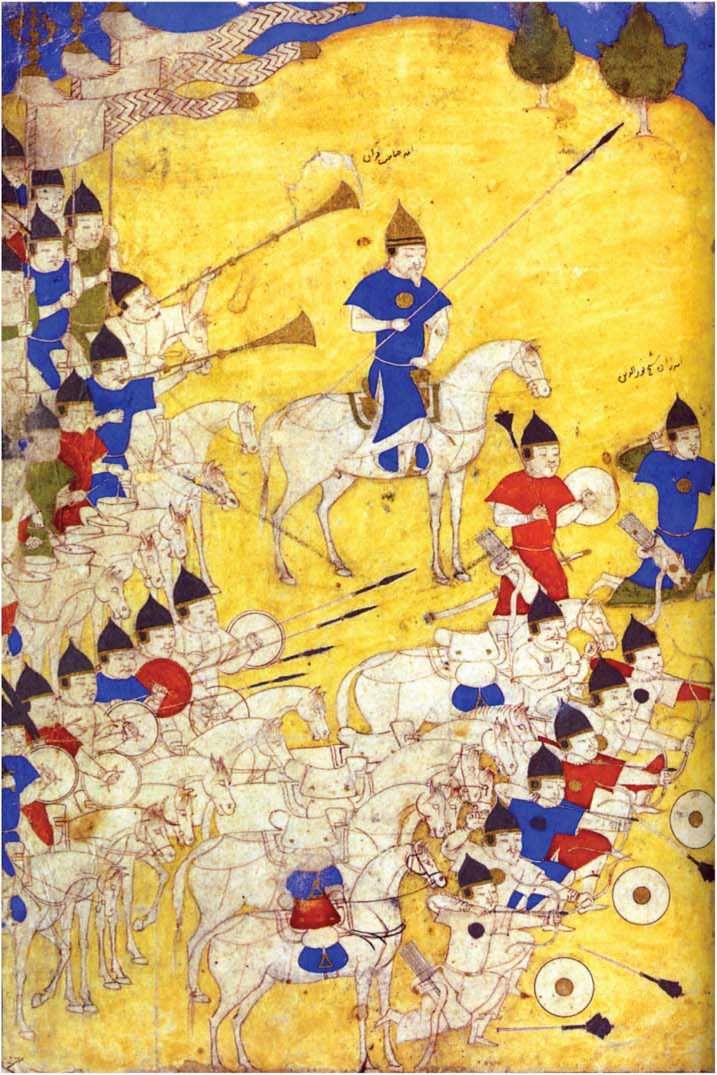
In 1225 after the death of Jochi, his lands by the decision of Genghis Khan passed to the authority of Batu, son of Jochi. Orda, another son of Jochi, the senior among the descendants of Jochi, had the territory of modern East Kazakhstan.
East Desht-i Kipchak under the authority of Orda’s descendants
The medieval chronicler of the Mongols, Rashid al-Din said that «Orda was in charge of one half of Jochi khan’s troops and the other half — Batu». Orda with his younger brothers Udur, Tuka-Timur, Shyngkur and Singkur «was the left wing of the army. They hitherto called princes of the left wing». After the completion of the «Western campaign» (1237–1242) Batu and his brothers, who formed the right wing of the army Juchids moved to the Volga and further to the west, taking control of the West Kipchak (Cumans) tribes.
«Oglans (batyrs — heroes) left wing» led by the Orda distributed among themselves and nomadic tribes of East Desht-i Kipchak. Orda’s ulus had been gradually formed into an autonomous structure comprising a single Mongol Empire already during his lifetime. Later, on the basis of his ulus an independent state — Ak-Orda (White Horde) will be developed.
According to Rashid al-Din, despite the fact that followers of Batu remained supreme rulers of the Ulus of Jochi and followers of Orda «recognize kings and rulers their successors Batu and write their name on the labels of their top» two wings of the Jochi Ulus to the middle of the 13th century gained more and more independence and since that time «did not happen, that from Uruk (i. e. tribes — auth.) Orda those who have taken up his place to the khans were Uruk Batu, because they are far away from each other and each was an independent sovereign of his ulus».
In the second half of the 13th century during the disintegration of the Mongol empire its vast western possessions become independent. Ak Orda during the reign Konkirana (Cong-Kiran), the successor of the Orda subordinated to the Supreme khans Juchids Berke and Meng-Timur. But these khans still did not interfere in the internal affairs of Eastern Juchids. After the death of Mangu Timur in 1380 Ak-Orda gained independence. It was due to the first political crisis in the Batu’s territory — Golden Horde, where the power of general Nogai began to grow, also the autonomy and isolation of Orda ulus (White Horde) was more and more.

Silver dirham Urus Khan. Sygnak. 774, (1372-1373) The State Hermitage museum St. Petersburg.
Formation of independent state
From the second half of the 1270, Konichi (Koishi, Kuindzhi and Turuk-kaan), the grandson of Orda and son of Sartaktay, was on the throne of White Horde. He managed to strengthen the institutions of government. The stable positon in the political life of the state was the main characteristic of his governance. European traveler and merchant Marco Polo noticed it: «King („North“ Konichi — author) have a lot of people, but he did not fight with anyone and peacefully ruled».
Konichi maintained friendly relationship with Iranian ilkhans like Argun, Geyhatu and Gazan, while Batu’s successor had war with them. To ease the growing power of the Haidy state, Konichi, Tuda-Munke and Nogai established alliance with the Yuan Empire.
During these years, Ak-Orda has developed as an independent state. It abandoned old formal vassal relations with Karakorum and Saray. However, after the death of Konichi in 1299 (1301), political stability was broken, his successors began a fierce struggle for power.
Feuds of Eastern Juchids and the Golden Horde protectorate
Civil war that erupted at the beginning of the 13th century, not only weakened the Ak-Orda, but actually split the country apart.
In 1301, the power in Ak-Orda passed to Kubluk (Kupalak, Kuylyuk), son of Timur-Buka and grandson of Orda, with the support of the Chagatay ulus’s rulers.
The eldest son of Konichi Bayan, who had hereditary right (perhaps he already was ruler) to power in East Desht-i Kipchak, was against of it, but he was defeated by Kubluk’s troops and his allies. After this defeat, Bayan fled to the western part of the possessions of his father, to the borders of the Golden Horde, where Tokta ruled.
In 1302 Kubluk was defeated and overthrown. The khan of Ak-Orda became Bayan. However, rulers of Mawarannahr did not leave any hope to nominate their candidates to the position of Ak-Orda’s head. Haidu’s sons Chapar and Tuva nominated a new candidate to the power — a son of Kubluk Kushtui (Kushay, Kush Temir).
The tribal aristocracy of Ak-Orda, which nominated Mangytay (Makuday), the youngest brother of Bayan, as protégé, had advantages of weakling of the supreme authority. Ak-Orda split into three possessions. South part belonged to Kushtay, Mangytai had central regions and west part belonged to Bayan.
In the second decade of the 13th century Bayan managed to overthrow their enemies and return power to the Ak-Orda. Obviously it won’t happen without the help of the Golden Horde troops. Since that time, Ak-Orda recognized dependence on the Saray.
From 1318 to 1321, the ruler of Ak-Orda for a short period of time was Bayan’s successor and son of Sasy-Buka.
After the death of Sasy-Bika with the approval of Uzkek Khan a new ruler of Ak-Orda became Erzen. His contemporaries wrote that he was intelligent and educated, had great power in the country, and «the degree of his power became close to the greatness of Uzbek Khan». «He turned Turkestan to prosper and secure place. After his death nobody did not imagined such position».
Restoration of political stability and economic power of the state had pushed the state elite of Ak-Orda to fight for the restoration of independence. The group fighiting for it was headed by the song of Erzen, in other sources — Tukay Mubarak-Khoja khan (1338–1340). After taking over the power in the country, he began mining its own coins, which has always been the prerogative of the sovereign ruler.


Silver dirham Mubarak-Hodja-Khan labeled “Sultan rightly Mubarak-Hodge, may Allah prolong his kingdom". Sygnak. 729 or 739 (1327-1328 or 1337-38). The State Hermitage museum St. Petersburg.Drawing (by P. Savelyev).
To suppress the uprising of Mubarak Khoja Uzbek khan in the last year of his reign sent his son Tenibek, who managed to overthrow the Mubarak-Hodge and to take over the throne. Less than a year Tenibek Khan was in Sygnak and received news of the death of his father. He returned to the Saray, but on the way was killed by his brother Dzhanibek.
About two years (1342–1344) there was no official approved khan in Ak-Orda. The power belonged to Chimtay, who only in 1344 was approved as the new ruler of Ak-Orda by the approval of Dzhanibek. He was not active in foreign policy. All his activities were directed to the restoration of political stability, which «was broken during governance of his brother», in the country. In general, the Chimtay’s reign, seventeen years, prepared Ak-Orda for a further strengthening and elevation of it. While this state grew stronger and gained strength, the Golden Horde had difficult period, twenty years, of turmoil and strife. A distinctive feature of his reign was the prevalence of Orda’s descendants over Batu khan’s descendants. At the same time the arena of political struggle was occupied with other branch of Juchi’s descendants — Shibanids
The Rise of Eastern descendants of Juchi Khan
Urus Khan, son and heir of Chimtay, after becoming the head of the county (1361–1377), began to proactive activities to centralize power and to unite possession of all rulers of the left wing under his rule. He attracted the state elite to his side. He managed to suppress separatism of other representatives of Juchi khan’s descendants in Eastern Desht-i Kipchak.
From 1361 to 1368, Urus Khan had an intensive fight with internal separatism. He managed to unite former territory of Ak-Orda, cities near Syr Darya and primarily the capital of Ak-Orda Syganak city. He suppressed existing decentralized trends.
By the end of 1360, he joined North territory near Aral, Mangystau and Western Kazakhstan.
In 1372, Urus khan fought against the Golden Horde (Jochi ulus). During the 1374–1375 he conquered Saraichik, Hadzhi-Tarhan, Saray and began minting own coins here. At the same time the son of executed Tui Khoja-oglan Toktamysh had support from the governor of Mawarannahr barlas Emir Timur. Urus Khan left his vicar in the Volga region and returned to his main territory — Ulytau and lands near Syr Darya region.
In the autumn of 1376 the troops of Urus Khan concentrated at Sauran. Timur with his troops approached to surroundings Otrar. Unfavorable weather postponed the decisive battle of opponents. In small battles generals of Timur were defeated by Urus Khan. In winter 1376–77, having lost many people, horses and provisions, Timur moved to Samarkand and Kesh. In 1377 Urus Khan died.

Sygnak.The ruins of the mausoleum. Southern Kazakhstan. 14th -15th centuries. Photo, A. Jakubowski, 1927.
Territory
It is difficult to determine the territory where the power of Orda and his descendants was spread. At various time it varies from one to another depending on the political situation in and beyond Orda’s ulus. At the initial period the descendants of Orda khan owned steppes of Eastern and North-Eastern Kazakhstan. Later they moved to the south, took control of the South Kazakshtan with Sauran, Sygnak, Dzhend, Barchkend and other cities. The territory of Ak-Orda spread from east to west part of the country, but it is not exact fact.
At the beginning of the 14th century, the khans of Ak-Orda extended their power over the western part of Kazakhstan, reaching the east coast of Zhaiyk.
These lands became part of the possessions of Orda khans’ descendants during Urus Khan’s reign, when he took over the steppes of the Lower Syr Darya and Northern Aral Sea region of Mangistau.
Economy
The main population of the Ak-Orda was nomads. Principles and the nature of nomadism, the composition of herds have not changed significantly for many centuries. Nomads still led the semi-nomadic pastoralism. They retained their nomadic routes and stationary winter settlements. According to some sources, often nomads of East Desht-i Kichak during the winter period migrated from Saryarka to Zhetysu near Karatu, Aksy and Lepsy shores. They moved there by the frozen Balkhash. Modern archeological research mentioned about widespread tradition of agriculture among the nomadic steppe.
Nevertheless, hunting remained important in the economy of the nomads of Kazakhstan in 13th- 15th centuries. Skins and furs were main things of trade. Marco Polo, describing Konichi’s possession, said following about its people: «those who live here in the mountains and the valleys are big hunters. They catch a lot of „expensive“ animals, and had big profit from them. They caught ermine, sable, squirrels, foxes and many other expensive animals. Then they made expensive high price fur coats. They have such a shell that does not slip».
Economic development and trade in the Ak-Orda was influenced by stable political development, which is characteristic for a longer period of the history of this state, the homogeneous character of the country, in contrast to the Golden Horde, which was typical for heterogeneous condition that required constant and strong central government. Expansion of the territory of the State in the 14th century, including its constituent cities near Syr Darya pool contributed long-term preservation of military and political power of the state.
Feuds and wars made negative impact on the economic and political development of the Ak-Orda (during the reign of Bayan and Mubarak in the first half of the 14th century). In the last quarter of the 14th century the economy Ak-Orda experienced a period of decline, primarily due to a destructive campaign of Emir Timur and the involvement of the Ak-Orda to fight for the Golden Horde’s cities of the Volga region.
Religion
Despite the long-standing dominance of Islam in the East and Desht-i Kipchak before the arrival of the Mongols, most of the nomads still professed Tengrianism. With the arrival of the Mongols position of Islam briefly weakened, replaced the traditional religious beliefs of nomads.
According to the Marco Polo, Konichi khan’ subordinate strictly «follow the Tatar (Mongol auth.) law, and this law is very wild. They made their god of felt and called it Nachigay».
At the same time, Jochi khan’s sons had already begun to convert to Islam. Berke was an active supporter of Islam. Some Orda khan’s sons had Muslim names.
However, the formal adoption of Islam in Ak-Orda was held simultaneously with the same phenomenon in the Golden Horde, possession of Chagatai khans’ descendants, only in 1320’s.
In the 14th century, Kazakhstan’s population had already started to practices Islam.
Islamization has resulted in two significant phenomena: the construction of various religious institutions — mosques and madrassas, which were erected by khans of Ak-Orda in their cities, and the other — khans began to add to their names the new Muslim names. Urus khan became Urus Muhammad. Toktamysh and another descendant of Jochi became Mahmoud Toktamysh. Other descendants of Genghis khan had Muslim name at birth: Mubarak Hodja, Jalal al-Din Muhammad, and so on.


Battle of Toktamysh Khan with Emir Timur. Medieval oriental miniature. Herat. 1420-1440, Museum of Topkapi. Istanbul.
The decline of the Ak-Orda
Fighting of descendants of Urus Khan with Toktamysh, destructive campaigns of Emir Timur and the war for the city of Volga caused the decline of the economy, trade and urban culture in the Ak-Orda. The change of political center of the Ak-Orda to the Volga region was caused by the Toktamysh’s arrival to the power. Many researchers have linked this event with a temporary restoration of the former unity of Jochi khan’s ulus.
Sary-Arka and steppes of Eastern Kazakhstan, nominally recognizing the power Toktamysh, were run by local tribal nobility. Some of them, such as Mangyts, Kongyraty, held high military positions in the Toktamysh’s state. Others began to support the descendants of Urus Khan, who sought to reassert its authority. If Kuyurchuk failed, his son Barack was able to successfully unite under his authority the former Ak-Horde territory.
However, prior to this strengthening tribal aristocracy and the decentralization of power has led to new conflicts, resulting the death of Barak, and there was a collapse of Ak-Orda. Steppe aristocracy supported young Abulkhair, a representative of another branch of Jochi khan’s descendants — Shibanids. However, descendants of Urus Khan has continued to rule in some parts of Ak-Orda, and only strengthening Abulkhair’s power forced Kerey and Zhanibek, seniors in the offspring of Urus Khan, to migrate to the east to the Moghulistan. This event caused formation of the Kazakh state.
Kanat USKENBAY
